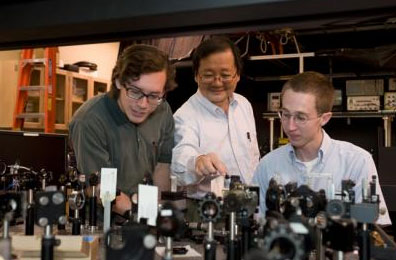| Posted: July 4, 2010 |
Researchers use super-high pressures to create super battery |
|
(Nanowerk News) The world's biggest Roman candle has got nothing on this. Using super-high pressures similar to those found deep in the Earth or on a giant planet, Washington State University researchers have created a compact, never-before-seen material capable of storing vast amounts of energy.
|
|
"If you think about it, it is the most condensed form of energy storage outside of nuclear energy," says Choong-Shik Yoo, a WSU chemistry professor and lead author of results published in the journal Nature Chemistry.
|
 |
| Washington State University chemist Choong-Shik Yoo, seen here with students, has used super-high pressures to create a compact, never-before-seen material capable of storing vast amounts of energy.
|
|
The research is basic science, but Yoo says it shows it is possible to store mechanical energy into the chemical energy of a material with such strong chemical bonds. Possible future applications include creating a new class of energetic materials or fuels, an energy storage device, super-oxidizing materials for destroying chemical and biological agents, and high-temperature superconductors.
|
|
The researchers created the material on the Pullman campus in a diamond anvil cell, a small, two-inch by three-inch-diameter device capable of producing extremely high pressures in a small space. The cell contained xenon difluoride (XeF2), a white crystal used to etch silicon conductors, squeezed between two small diamond anvils.
|
|
At normal atmospheric pressure, the material's molecules stay relatively far apart from each other. But as researchers increased the pressure inside the chamber, the material became a two-dimensional graphite-like semiconductor. The researchers eventually increased the pressure to more than a million atmospheres, comparable to what would be found halfway to the center of the earth. All this "squeezing," as Yoo calls it, forced the molecules to make tightly bound three-dimensional metallic "network structures." In the process, the huge amount of mechanical energy of compression was stored as chemical energy in the molecules' bonds.
|

